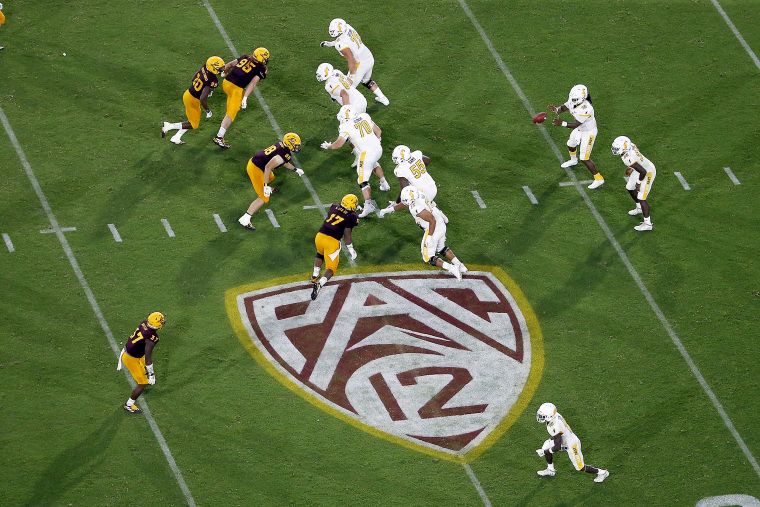The Pacific-12 Conference announced Thursday it'll play fall football after all, following in the footsteps of other colleges in hastily getting back on the field despite the ongoing coronavirus pandemic.
In a statement, the conference said that football teams approved to play by local and state health officials can kick off Nov. 6, while basketball will begin Nov. 25.
Weekly Covid-19 tests will be required for the players, the conference said.
Pac-12 said it had taken a number of factors into consideration in changing course, including "material changes to testing capabilities" and updated guidelines from health officials. Student athletes will be subjected to consistent cardiac-monitoring protocols to detect any potential health risks, and fans will not be allowed at the games.
"The Pac-12 institutions are also participating in a national COVID-19 cardiac registry which will allow for medical practitioners to monitor closely, and gain greater insight into, potential health outcomes in student-athletes," the statement said.
The Mountain West Conference also reversed course in an earlier announcement and said Thursday it would get back on the football field this fall.
Dr. George Rutherford, a professor of epidemiology at the University of California, San Francisco, said the testing regimen planned by the Pac-12 should work, as long as everyone follows the protocol and quickly goes into isolation if found to be infected.
But he questioned the need for college football when most schools don't have students on campus.
"I’ve always felt pretty good about the chances of not having outbreaks" with proper testing and protocols, Rutherford told NBC News on Friday, "but it seems a little weird to not have students on campus, yet having football."
Thursday's announcement by the Pac-12, which is comprised of a dozen prominent West Coast and Mountain time zone universities, completely flipped the script the conference had written just six weeks ago, when it announced all intercollegiate sports would be sidelined until 2021.
But the Pac-12 faced increasing calls to play after the Big 12 and Atlantic Coast Conferences got on to the field earlier this month, and the superpower Southeastern Conference announced its plans to kick off this upcoming Saturday.
The push to play reached critical mass a week ago Wednesday, when the Big Ten said it was going to begin play again on Oct. 24.
The Big Ten and Pac-12 had both announced on Aug. 11 that they wouldn't play any football in 2020 due to coronavirus, and would instead target an early 2021 or spring restart.
On Thursday, President Donald Trump congratulated himself in a tweet for encouraging the conference to play: "GREAT NEWS! PAC- 12 football is back this Fall! Congrats to the players, their families, the coaches, and the universities. The west coast games will kick off soon – You’re welcome!!!"
While they encompass two completely different regions of the country, the Big Ten and Pac-12 share similar identities, unique from the other so-called Power 5 conferences.
Both play in major urban TV markets such as Los Angeles, Chicago, San Francisco, Seattle, Phoenix and Detroit and include some of the nation's most elite academic institutions, like Stanford, the University of California, Berkeley, UCLA, Northwestern and Michigan.
And for almost a half-century, the Pac-12 and Big Ten football champions met annually in the Rose Bowl, a New Year's Day TV tradition known as “The Granddaddy of Them All" that showed off sunny Southern California when much of America is still covered in snow.

